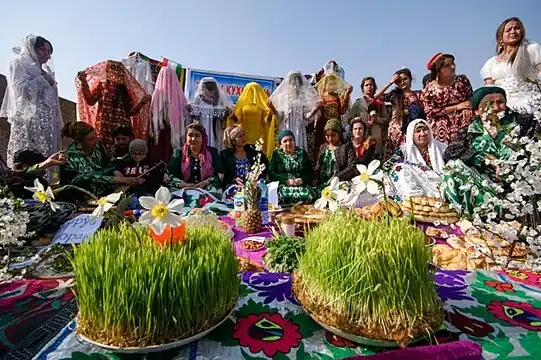| Navroʻz | |
|---|---|
 An Uzbek woman in traditional clothes stirring sumalak | |
| Date | 21 March |
| Next time | 21 March 2024 |
| Frequency | Annual |
| Related to | Nowruz |
Navruz (Uzbek: Navroʻz / Наврўз) is celebrated widely in Uzbekistan. It is the day of the vernal equinox, and marks the beginning of spring in the Northern Hemisphere. It has been celebrated on the territory corresponding to modern-day Uzbekistan for at least two thousand years.[1]
When Uzbekistan was part of the Soviet Union, celebrations of Navruz were generally unofficial, and at times even prohibited.[2] Currently Navruz is an official public holiday in Uzbekistan and is always celebrated on March 21. Still, holiday celebrations are spread out over several days.
History
Navruz widely celebrated on a vast territory of Central Asia and ritual practice acquired its special features. The festival was legitimized by prayers at mosques, and visits to the mazars of Muslim saints and to sacred streams. In the Emirate of Bukhara, a broad official celebration of Navzur was started by Muzaffar bin Nasrullah, who sought to strengthen the image of the Manghud dynasty during the crisis of political legitimacy.[3]
Navruz customs
In preparation for the holiday, people tidy their homes and mahallas (neighborhoods), and buy new clothes. Before, during, and after Navruz, it is customary to prepare sumalak, the main ceremonial dish of the holiday. Sumalak is a sweet paste made entirely from germinated wheat and is cooked in a large kazan. To prepare sumalak friends, relatives, and neighbors – usually women – gather around the kazan, all taking a turn to stir the mixture. When ready, sumalak is distributed among neighbors, relatives, and friends. At Navruz, people also visit relatives and friends and give presents to children.
Navruz is often cited as the most popular holiday in Uzbekistan.[1] On March 21, elaborate holiday concerts are organized across the country, notably in the capital city of Tashkent. Book fairs, concerts, games, and special televisision and radio programs last for the whole month of March. It has been noted that after Uzbekistan gained independence in 1991, government officials have promoted Navruz as a main national holiday and have tightly controlled the content and form of the festivities.[2]
Gallery
_(5612819864).jpg.webp) Navruz celebrations in Bukhara
Navruz celebrations in Bukhara_(5614065867).jpg.webp) Cooking sumalak for Navruz
Cooking sumalak for Navruz Navruz foods (with germinated wheat in the foreground)
Navruz foods (with germinated wheat in the foreground) Germinated wheat
Germinated wheat Children celebrating Navruz in Samarkand in 19th-century Russian Turkestan
Children celebrating Navruz in Samarkand in 19th-century Russian Turkestan Navruz on an Uzbek stamp
Navruz on an Uzbek stamp
References
- 1 2 Sahadeo, Jeff; Zanca, Russell, eds. (2007). Everyday Life in Central Asia: Past and Present. Bloomington: Indiana University Press. pp. 202–203. ISBN 9780253013538.
- 1 2 Tursunova, Zulfiya (2014). Women's Lives and Livelihoods in Post-Soviet Uzbekistan: Ceremonies of Empowerment and Peacebuilding. London: Lexington Books. pp. 26–27. ISBN 9780739179789.
- ↑ Malikov, A. M. (26 June 2020). "Celebration of Nowruz in Bukhara and Samarkand in Ritual Practice and Social Discourses (the Second Half of the 19th to Early 20th Centuries)". Archaeology, Ethnology & Anthropology of Eurasia. 48 (2): 122–129. doi:10.17746/1563-0110.2020.48.2.122-129.